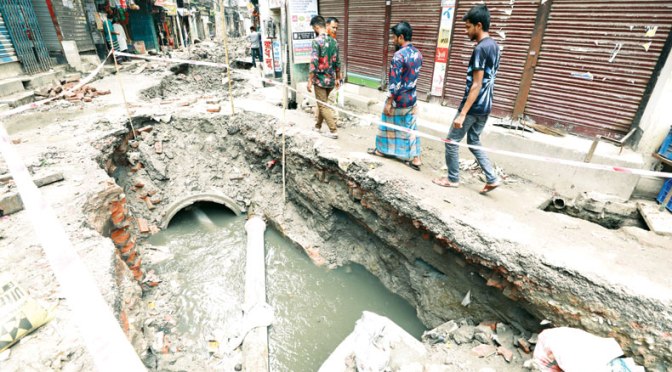Once a mighty river, Karatoa now no longer meanders through the northern region of Bangladesh in a long continuous stream.
The sluice gate built for regulating water flow upstream from ‘Bangali’ River during the 1988 flood acted as a bane in later years, thanks to the Bangladesh Water Development Board’s impoverished plan.
The gate at Khulshi in Gobindaganj under Gaibandha district was constructed over five-feet higher than the natural river bed at the tributary of River Bangali obstructing the flow of water downstream in dry season.
The BWDB has long been trying to remove the obstacle, but is yet to make any headway.
Green activists say that as the river remains dry in many parts for months, grabbers take the advantage of illegal sand lifting from the riverbed.
They lamented that the 123-kilometre high tide river linked with rivers originated in India had almost turned dead making various environmental impacts on the people and ecosystem centering the river.
The BWDB executive engineer Md Nazmul Haque said that the water board identified the problem relating to the sluice gate that led to a series of other problems like parched riverbed, grabbing, sand lifting, etc.
But, he said that the BWDB had taken up the ‘Karatoa River Development Project’ to restore water flow in the river and was conducting a feasibility study.
‘The Tk 2,942-crore project also involves reconstruction of the sluice gate to bring life to the river,’ argued Nazmul.
The feasibility study report will be ready by May, he said, adding that development work would follow then.
Apart from the floodgate, the official laid blame on other factors, most importantly, water crisis in all 57 trans-boundary rivers and sedimentation in riverbeds for lack of water flow.
An elderly Khalshi resident Abdur Rahim said that before the gate was built, they used to get water in Karatoa round the year like that of the Bangali River.
National River Conservation Commission chair Manjur Ahmed Chowdhury said that not only Karatoa but also many other rivers and canals had lost their natural flows due to faulty constructions of sluice gates, dams and embankments.
‘When a river loses its navigability, it faces faster pollution, grabbing and the like,’ he pointed out.
Manju also mentioned that many sluice gates were unnecessary in many rivers, but they had been built there for reasons unknown.
The NRCC is working to make sure that approval is taken for building any structure on the river from the NRCC committee at local levels led by deputy commissioners.
During a visit to the area, a three-chamber water regulator constructed after narrowing down the river was found open, but there was no flow of water, though water was found in Bangali River upstream.
Some 15-feet wide water gate was found roughly five feet from the water level and 8 feet from the Banglali River bed.
The sluice gate downstream was literally dry, and a large portion of the river has already been grabbed by sand traders.
In 2015, the High Court following a writ petition filed by the Bangladesh Environmental Lawyers Association ordered agencies concerned to take measures to restore water flow in the river, evict grabbers and stop river pollution but the order was grossly violated.
Bangladesh Poribesh Andolon Bogura unit general secretary Ziaur Rahman said that the local authority attempted time and again to stop grabbing the widest river in Bogura but stopped halfway through.
Karatoa is now transformed into a ‘drain’ where all sorts of domestic and industrial waste are dumped, he added.
To save the river, local people formed a 123-kilometre human chain in 2020 and over two lakh people signed en masse to protect the historic river, said Zia.
Mahasthangarh or Pundranagara, the ancient capital of Pundravardhana, one of the oldest civilisations of the region, was developed on the bank of the river.
The activist said that out of 18 rivers in Bogura four were almost dead and finally Karatoa was on the verge of extinction.
‘If Karatoa cannot be protected now, it will be never,’ he said, mentioning that at many parts of the river people were running their farming activities while illegal sand lifting and grabbing were underway and chocking the river.
Ziaur Rahman too blamed the unplanned floodgate that facilitated the river grabbing and pollution.
Local administration took some piecemeal initiatives to free the fiver from pollution and evict grabbers but to no avail, he said.
BELA chief executive officer Syeda Rizwana Hasan said that the unplanned sluice gate must be removed from the river and the agencies concerned must follow the HC order to restore the lifeline.
‘Evict all grabbers whoever they are,’ she said.
Dry food vendor Ananda Chandra Das, who compelled to change his profession as a fisherman, said that he caught fish from the river in rainy season only but not round the year.
For three to five months during rain different types of fish are available, but there is no fish for the rest of the time, he added.
‘The river water stinks and it causes skin disease,’ Ananda told this reporter in the first week of April.
Majhipara Samabay Samity president Chittananda Das said that over 2,000 families in Chelopara and other villages that lived on fishing migrated to different cities and the rest were compelled to change their profession.
Abdul Khaleque, general secretary, Bogura Paribesh Unnayan Nagarik Committee, said that individuals, government and non-government organisations were to blame for grabbing and polluting the river.
Published on New Age

